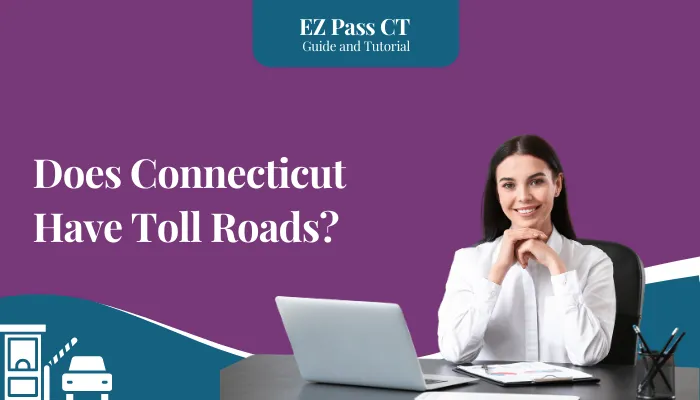Does Connecticut have toll roads? This is often the case for people driving through the state. Becomes a necessity whether you are a traveler or a driver. Regardless of whether you are from the area or only briefly stopping by, taking note of Connecticut’s toll system is essential to traveling seamlessly.
So if you are planning a drive in Connecticut, it is important to know the locations of the toll booths and the methods of payment to ensure that your time and money are spent in a wise manner. There are certain tools, like the EZ Pass CT which will assist you in relieving the burden of toll payments. So what overall does the toll system in Connecticut look like, let us dig in deeper.

Understanding Toll Roads in Connecticut
Does Connecticut have toll roads? Because Connecticut was nascent in its construction of toll roads until recently, this question becomes deeply fascinating. Up until recently, toll booths did not greet drivers who traveled across the state.
However, the times have changed, and toll roads have firmly established themselves in the Connecticut driving culture. Let’s focus on the location of these tolls, their functioning, and the most efficient ways to use them.
Development of Tolling in Connecticut
Tolls in Connecticut were once limited to certain highway stretches like Merritt Parkway and Wilbur Cross Parkway. By the mid-1980s, these tolls were removed. However, in the last decade, the state has started looking into the construction of tolls on its highways.
Efforts to improve and maintain the infrastructure, roads, and bridges have resulted in the debate surrounding tolling coming back into the political spotlight.
Existing Toll Roads within Connecticut
Indeed, the state of Connecticut has toll roads, which became a reality in 2021. Zoning in on the question: Does Connecticut have toll roads? The answer is yes. Alongside several highways, Connecticut has started placing tolls on primary roads.
This is part of a gradual objective from the state that hopes to allow Connecticut to fund projects such as bridge repairs and tolling highway improvements.
Current Toll Locations
Currently, tolls are placed in areas that receive heavy pupulation, including:
- I-95 (Connecticut Turnpike): This busy highway constructed next to the coastline has several tolls, similar to the way it is placed on other heavily used roads.
- I-91: This significant highway has been fitted with a toll booth with the intention of generating revenue.
- I-84: Both I-84 and I-91 are expected to have tolls eventually, as they provide extensive linkage to highways in Waterbury and Hartford.
Toll Collection Systems
Connecticut employs a system of collecting tolls that is fully digital, allowing for no booths to be constructed and better mobility for cars. Towing is paid electronically through the cars, while the state place toll sensors in the highways.
Additionally, the EZ Pass CT is also utilized, allowing drivers to attach it to their vehicles and have the towing fee instantly deducted as they travel underneath the sensors.
Car owners who do not possess an EZ Pass CT or a similarly valid transponder will rely on a procedure that connects them to the license plate of the vehicle used. You will receive an invoice to your address for the toll charges. The regulations in some states also allow this method to work.
Why Did Connecticut Implement Toll Roads?
What is the reason that Connecticut decided to implement these toll roads? The most important goal is to increase the amount of revenue that can be used for expansion and preservation of the transportation system of the state. Connecticut has some old bridges, highways, and roads that require continuous attention.
The tolls might also play a role in state traffic management and enable the state to reduce the level of traffic by persuading motorists to use allotment routes or to travel by means of public transport.
Payment of Tolls in Connecticut
Does Connecticut have toll roads? Yes, and passage through these tolls is quite easy when one has the right tools and sufficient knowledge of their locations. In Connecticut, there are tolls with different payment options.
Using an EZ Pass CT
The preferred option offered in this state is the EZ Pass CT, which is the easiest and fastest way to pay for a toll in the state. The transponder is conveniently mounted to the vehicle, which means the customer does not need to stop at every booth. The cameras set at the booths capture the image of the car and send it over to a centralized place for payment docking.
Benefits for Use of EZ Pass CT
- Spend little time waiting in queues at the toll booths.
- The amount deducted from a person s account is lower when compared to the use of a credit card without the device or manual payments.
- All the transactions are carried out through an online account which makes it easy to keep track of the charges.
Paying Through Mail
Those customers who do not possess the device along with those who wish to not use the device will still receive a mail bill through the Pay-By-Plate service. When the driver crosses the toll point, the device records the license plate number of the vehicle.
After a while, an invoice is forwarded to the user for the amount owed for the tolls. The system in place is such that it does guarantee the required revenue from all users of the highway.
Other Payment Methods
Connecticut’s toll roads allow payments via credit card through the toll booths. However, the reasonably priced and most convenient option for paying tolls on Connecticut’s highways is still through EZ Pass CT.
Note: The processed payment types usually add to the costs as paying via mail may incur added administrative fees.
What Are The Consequences Of Not Paying The Toll In Connecticut?
Does Connecticut have toll roads? Yes, and it’s important to understand that there are consequences for not paying tolls. If you do not pay your tolls within the specified time, you may face late fees or even fines. Extended failure to comply can incur a suspension of your vehicle registration in Connecticut, and even prevent you from using your vehicle until you clear the overdue payment.
Using EZ Pass CT further enables for these prompt payments to be made with ease instead.
Connecticut Toll Costs
In Connecticut, toll pricing is dependent on the highway, as well as the type of vehicle using it. For standard passenger cars, crossing total goes anywhere from one to four dollars for every crossing. Rates might be higher for other vehicles like trucks.
Toll Charges
| Highway | Tolls (for Passenger Vehicles) |
|---|---|
| I-95 (Connecticut Turnpike) | $1 to $3 |
| I-91 | $1 to $4 |
| I-84 | Tolls yet to be implemented |
Confirming updated rates before commencing travel is critical. Such information aids in planning routes and roads to use while ensuring the plan remains cost effective.
Conclusion
Does Connecticut have toll roads? Yes, and the state is actively working to improve its infrastructure through tolling. For instance, the introduction of electronic systems such as the EZ Pass CT has made paying tolls much easier and accessible to almost every driver in Connecticut.
And it doesn’t matter whether you are a resident or just passing through the state, understanding how the tolling system works makes driving more easy. Keep in mind, do pay the tolls in a timely manner to avoid penalties so that your journey is actually enjoyable.
